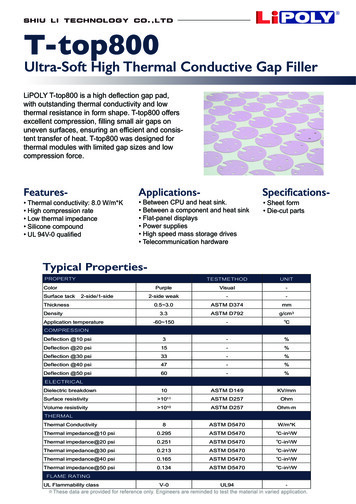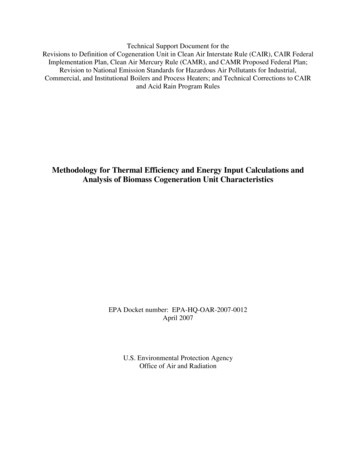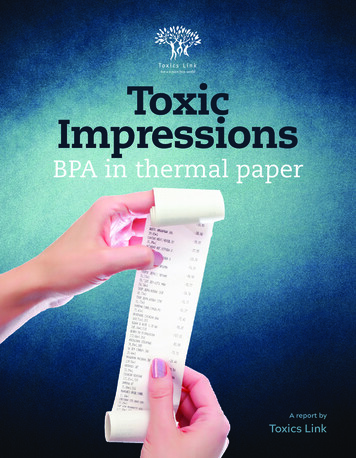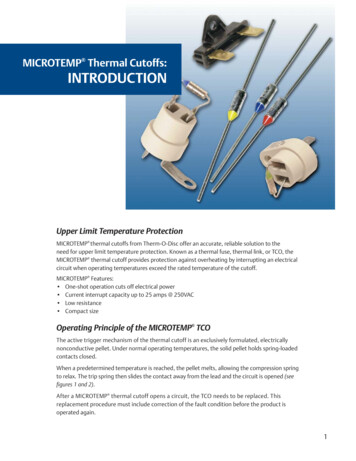
Transcription
“Thermal Management Strategiesfor Existing Data Centres” Confederation of Indian Industry
Data Centers Main Thermal Management NeedsCapacity:Always available, following the dynamicdata centre’s environment: peaks, loadvariations.Efficiency:Optimized for all conditions minimizing the pPUE valueAvailability and Reliability:100% cooling guaranteed even in themost extreme conditions
50% of DC Power for PhysicalInfrastructureElectricityLighting, etc.Transformer/3%UPSIT Equipment10%50%AirMovement12%Cooling25%The direction of energy efficiencyPUE Total Facility PowerIT Equipment Power(common PUE 1,6 bis 3,5)Source: EYP Mission Critical Facilities Inc., New York, PUE 2
The Data Center World - OperatingThresholdsASHRAERecommended EnvelopeTypical Application: Legacy DC withReturn Control and High Precision onHumidityHardware: All ServersTemperature & Humidity: 20 C – 25 C,40% – 55% RHTypical Application: Current DC withReturn or Supply Control and HumidityControlHardware: All ServersTemperature & Humidity: 18 C – 27 C,5,5DP – 60% RH&15DPASHRAEAllowable EnvelopeTypical Application: Information andTechnology Space or OfficeHardware: Volume servers, storageproducts, pc, workstationsTemperature & Humidity: 10 C – 35 C,20% – 80% RHTypical Application: DC with focus onEnergy Savings and larger limits onhumidityHardware: Enterprise servers,storage productsTemperature & Humidity:15 – 32 C, 20% – 80% RH
Everything Starts from the Server When IT Works, IT Makes HeatThe “Equivalent Circuit”Variable fan speed depending on inlettemperatureHot Discharged AirVariable power input depending on thefan speedCold Supply Air
Everything Starts from the Server When IT Works, IT Makes HeatIf Airflow is Not Enough HotAisleRecirculationCold Aisle
Air Distribution Concept
pilot project “ENERGY”Steps to improve Energy in existing Data Center Focus „ENERGY EFFICIENCY“ Two test conditions: full load: 280 kW in the room partial load: 180 kW in the room
Consistent Covering .warm 30 Clow return temperature22 24 Closs of cold airrecirculation„hot spots“ 30 Csmall delta Thigh air flowrecirculation to be eliminated step by step 100%fan speedair leaks – loss of cold air 18 Clow supply temperature 14 18 Chigh velocity – high pressurebalancing required
pilot project “ENERGY”
pilot project “ENERGY”
Airflow Can Vary Thermal Solution Always Needs to Match It!Servers’ Airflowq1qservers q1 q2 .qnq2Cooling Unit Airflowqcooling qserversqn12
Server Airflow Dynamic Control13
Control and Different IT Loads per AisleServer Airflow Dynamic ControlA step forward!14
Underfloor Pressure Control –Type of control to keep a constant pressure in the raised floor based on the differential pressure sensorPermanentpressure toequipmentLoss through slots20 Pa pressure Readings:o Inside the unit body or outside in the room (room pressure)o In the raised floor or cold aisle, Typical Application:15o Open architecture: 50 – 70 Pa , Hot / cold aisle containment: 10– 30
Control and Different IT Loads per Aisle - Pressure ControlMay be Critical!16
pilot project “ENERGY”full loadpartial loadNote: Heat blowers used; efficiency results aredepending from energy efficiency of the servers
Hot-Cold Separation38 C 24 C 10 C -
Conclusionpilot project “ENERGY” complete change of the philosophy(open frame closed racks andCoolFlex) CRAC units (n 1 2n) redundancy and more security Up to and more than 90% energyreduction for the run of the CRACunits (or more kW load is possible) Regulation of the cold aisle
Power Savings in Chiller after deploying CAC (Aircooled, Capacity-305 kW)Chiller OutletChiller InletPowerConsumption C CkW712103101591182469
Concept of the organized cold and hot areas
Direct Expansion Solution22
Upgrade/Replace - Direct Expansion Units
Energy Consumption of Different DX SystemsEnergy Consumption / 1 kW CoolingYearFloor Mounted DX System With FixedCapacity Compressor and operating at240 C2008IImproved Floor Mounted DX SystemWith Fixed Capacity Compressor andoperating at 240 CMMarket andCustomerRequirements:P2010ROVVariable Capacity Unit with AirEconomizer2012EMEVariable Capacity Unit with Cold AisleControlled Operation2014NTThe Data CenterTechnology trendanticipates higherservers’ workingtemperatures, lowerpPUE!Variable Capacity Unit with PumpedRefrigerant Economizer20162017
Chilled Water SolutionHow to Optimize Chilled Water SystemsHigh EnergyEfficiency Energy efficient floor mountunitHigh Efficiency EC FansFans extended in the raisedfloor Operation at high CWtemperatures (20/26 C)Via Freecooling ChillersVia Adiabatic FreecoolingChillersIntelligent SystemControlAdditional FeaturesMaximizeFreecooling Options for fast restartafter power outageManage the level ofpower/current absorbed Communication betweenindoor units and chillersChiller set point shifting incase of low heat load indata center25
Efficiencies improvements in the CW SOLUTIONSEnergy Consumption / 1 kW CoolingYearChiller at 15/10 0 C & Floor Mount2008Freecooling Chiller at 26/20 0 C Water & FloorMountIMarket andCustomerRequirements:M2010PROFreecooling Chiller at 26/20 0 C Water &Improved CW Unit2012VEChiller With Adiabatic free Cooling at 26/20 0 CWater & Improved CW unitM2014E2016!CW System 32 / 20 0 CNChiller With Adiabatic free Cooling at 26/20 0 CWater & Improved CW unit and variable waterflowTThe data centertechnology trendanticipates higherservers’ workingtemperatures, lowerpPUE: increase of water Tand water Delta T20172017 – CW System at 20 / 32 C – pPUE 1.06
Where Indirect Evaporative Freecooling / Adiabatic WorksDX/CW INTEGRATION: At 24 C and 90% relativehumidity, the unit might requireDX/CW integration. But, at 30 C (higher temperature) and35% (lower relative humidity) the unitcan work just with evaporative.DRY OPERATIONThe unit can cool the data center just viathe air-to-air Heat Exchanger thus usingonly external cold air.DInt X/CWegrationWET OPERATIONThe unit can here exploit theevaporative effect via : Data Center 36 C 24 C 100% of Full Load per Unit27
Typical InstallationRoof Configuration Data centers located on thetop of the buildingPerimeter Configuration Green field sites Warehouse data centers28
Indirect Evaporative SolutionOperation ModesOptionalWinterSummerEXTERNAL AIR TEMPERATURE IS TOO HIGH TOHAVE 100% COOLING WITH EVAPORATIVE, THE DXMODULE IS THUS INTEGRATED TO COVER THEMISSING CAPACITYAIR-TO-AIR HEAT EXCHANGE VIA THESPRAYING OF WATER TO THE EXTERNAL AIRSIDEDX/CW IntegrationAIR-TO-AIR HEAT EXCHANGE WITHOUTSPRAYING WATERWET OperationDry Operation29
MAXIMUM Optimization : System Logics of the ControlAdiabatic FreecoolingChillerDynamic ControlCommunications CRAC chillersCRACunitsAdiabatic FreecoolingChillerTEAMWORKCommunicationbetween Chillers Software function embedded in the units’ control Leverages the communication between indoorand outdoor units EFFECT: increase of freecooling at part-loadconditionsFreecooling Chiller30
Steps for Exisitng Data Centres Follow ASHRAE Cold Aisle / Hot Aisle Layout, Avoid Air mixing Implement Aisle Containments CFD Analysis Convert Fix Capacity Systems to variable (Fan / Compressors) Apply Supply Air control Raise the RA temperature Monitoring and control of Fans speed from Remote Cold Aisle sensors /Pressure sensors Raise the CW temperatures and Raise the CW deltaT Apply Free cooling/ Adiabatic wherever possible
Two Steps for Data Centre Efficiency Improvement Increase data center temperatures to the limit of the RecommendedEnvelope Move to the Allowable ranges A1-A4 as a result of evaporative cooling andadiabatic chilled water solutions
Questions &Answers
Thank youContact Details:Raghuveer Singhraghuveer.singh@vertivco.comM: 91 99209 59205 Confederation of Indian Industry
data center How to Optimize Chilled Water Systems. Efficiencies improvements in the CW SOLUTIONS 2008 2010 2012 2014 2016 Year 2017 . Follow ASHRAE Cold Aisle / Hot Aisle Layout, Avoid Air mixing Implement Aisle Containments CFD Analysis Convert Fix Capacity Systems to variable (Fan / Compressors)











